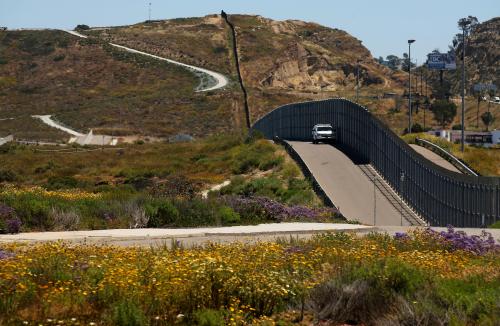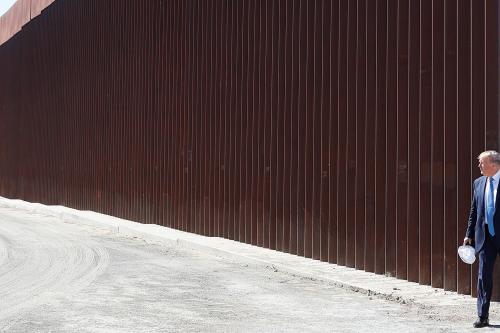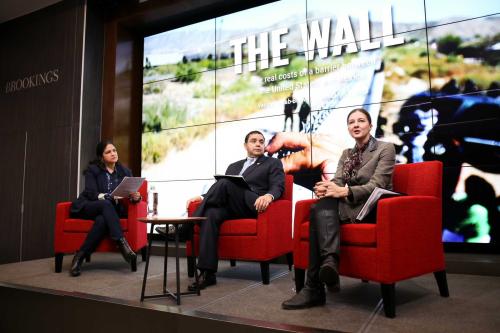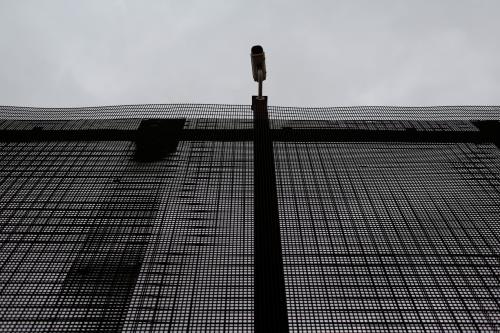In a manic attempt to make good on a campaign promise before the end of his first 100 days in office, President Trump tried to make funding for his big, beautiful wall on the Mexican border a condition for keeping the government open. And his administration also offered a dollar for dollar deal—one dollar for Obamacare subsidies for every dollar for the wall. That political calculus never did make much sense. As my colleague Bill Galston has pointed out, this is not a real estate transaction; to Democrats, health care for millions of Americans is simply not the same currency as Donald Trump’s wall. So, after several days, the White House backed off.
If the idea of building a wall makes little political sense, the president’s proposal to turn his campaign pledge into reality is even further off base.
For starters, Mexico will not pay for the wall. Not now. Not tomorrow. Not ever. And everyone, except Donald Trump, seems to know this.
Therefore, the question quickly becomes: are there better uses for the $25 billion or so that the wall is estimated to cost? Furthermore, will it work? In business terms, is it cost effective? The president has at his side his son-in-law, Jared Kushner, a corporate leader who could easily estimate a cost-benefit analysis on the wall and compare it to other alternative uses of those funds.
If he does, a little history is in order. In 2006, a Democratic Congress and President George W. Bush set out to bring about bipartisan immigration reform. Republicans were skeptical that the border was secure enough to ensure effective reform, and demanded the development of metrics to assess the level of security at the border. This came to be called a Border Condition Index. The Department of Homeland Security initially promised metrics to Congress, but eventually admitted that they had not made progress.
To placate the skeptics in his party, President Bush launched a comprehensive, costly, and ultimately doomed project called SBINet, the Southern Border Initiative Network. It was planned as a “virtual fence” that would stop illegal entrants at the border with a mix of guard towers, cameras, sensors and other infrastructure that would feed data to a sophisticated IT system for managing both of the U.S.’s land borders. But the system was plagued with problems. Four years and about $1 billion later, SBINet was dead.
The death of SBInet is a harbinger of problems to come for President Trump’s wall. The first of those is that any physical barrier solves only part of the problem. Some large portion of the illegal immigrants in the United States either entered using fraudulent documents or entered legally and then overstayed their visas. The second is the sheer difficulty of building barriers through the rugged and unforgiving terrain that constitutes much of the border. And, of course, with any wall, there are tunnels. The United States has found 150 tunnels under the U.S.-Mexico border since the 1990s.[1]
Building a wall on the southern border will also pit President Trump against some of his most ardent supporters in one of his best states—Texas. Before construction can even begin, the government will have to secure the land on the border needed for the wall. About two-thirds of the land along the border is privately owned and most of that is in Texas. That means that in order to build a border wall, the federal government would have to exercise eminent domain as was done when land was acquired for portions of the border where there is fencing. An Associated Press review of border-related eminent domain cases in 2012 found that “the U.S government spent approximately $15 million to acquire 300 properties along the border in Texas.” And a Washington Post piece by Karen Tumulty shows little enthusiasm for the wall in the congressional district that would contain a large chunk of it.
Although legal precedent is on Trump’s side, the fact is that exercising eminent domain is always controversial—especially among conservatives in the Republican Party. After the 2005 Supreme Court decision Kelo v. New London reinforced the government’s right to eminent domain, Republican members of Congress spoke out against it and introduced legislation to blunt its impact. In 2007, right-wing think tank The Heritage Foundation published a report called “The Decline and Fall of the Right to Property: Government as Universal Landlord.” And in the 2016 presidential campaign, Senator Ted Cruz of Texas ran an attack ad criticizing Trump on his use of eminent domain. Thus, in his desire to fulfill his campaign promise, Trump may end up facing the wrath of fellow conservatives dead set against the government taking property.
During the campaign, the wall became a powerful symbolic metaphor for getting tough on immigration. But President Trump is not the first president to discover that sometimes your best campaign lines turn out to be non-starters in Congress. Remember President Obama’s pledge to close the Guantanamo detention facility? That never happened either.
[1] Reece Jones, “Borders and Walls: Do Barriers Deter Unauthorized Migration?” Migration Policy Institute, October 5, 2016.
The Brookings Institution is committed to quality, independence, and impact.
We are supported by a diverse array of funders. In line with our values and policies, each Brookings publication represents the sole views of its author(s).











Commentary
Why the wall on the Mexican border won’t happen
April 25, 2017